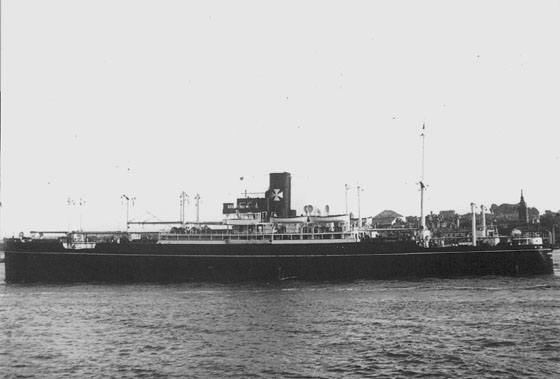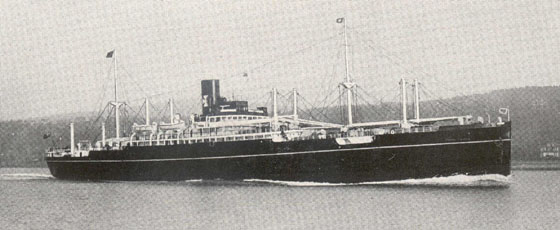
The Upwey Grange was built by Fairfield Shipbuilding & Engineering Co Ltd, Glasgow during 1925 as hull number 617. This vessel was one of the first of the motor vessels used to replace the Houlder Line’s fleet of coal-fired steamships. When built this was the largest refrigerated motor ship and the highest powered motor cargo vessel afloat at 9,130 tons gross and 6,400 horsepower. The ship would sail from Gravesend for Rio and Santos of Brazil and the Falklands as well as the usual ports in Uruguay and Argentina.
The Mercury (Hobart) August 10th 1925 reports (condensed):
The latest issue of the "Shipping World" says that the Fairfield Shipbuilding and Engineering Company, Glasgow, has to its credit a notable achievement, if not indeed a record, in that it has built, first of all the largest motor passenger liner afloat (the Aorangi), and now the most powerful motor-driven refrigerator ship, which is at the same time the largest meat carrier in the world. This, their latest vessel, which was launched on the Clyde last week, is the Upwey Grange, and has been built to the order of the Boulder Line, London. As the vessel is intended for the chilled meat trade from the Argentine, special attention has been paid to the arrangement of the cargo space, which is nearly all insulated. The hull is divided into four cargo compartments forward of the machinery space, and three aft, with seven cargo hatchways. There are 54 compartments for the carriage of chilled meat, with a capacity of 500,000 cubic feet, and also 3,000 cubic feet for the refrigerated ship's stores. A duct keel is included in the construction of the vessel. Space is provided 'tween decks for the carriage of general cargo. On the bridge deck house there will be accommodation for 12 passengers, all in single-berth staterooms.
An outstanding feature of thc vessel is her propelling machinery, which consists of twin sets of Fairfield-Sulzer Diesel engines of similar design to those fitted in the Aorangi. The difference between the two installations is that, whereas four engines driving quadruple screws were put into thc Aorangi, there are only two sets driving twin screws in the Upwey Grange. Each engine has six working cylinders, 28 inches in diameter by 39 inch stroke, and together they will develop 6,400 b.h.p. at 117 revolutions per minute. Two three-stage main air compressors are driven by cranks at the forward end of each eugine. The refrigerating machinery, together with auxiliaries, are all steam driven.
1926: March, the Upwey Grange, at the time the largest fully refrigerated motor vessel afloat, completed her maiden roundtrip voyage to/from South America in 50 days, and had brought the largest refrigerated cargo of chilled and frozen produce which had ever been shipped from South America. The success of the Upwey Grange in its first year would lead to the Houlder Company ordering a second motor vessel at the end of 1926. The Upwey Grange would lose its 'largest refrigerated ship' title to the Dunster Grange during 1928.
1930: February 21st, noted London unloading meat from South America.
It is reported that the first public telephone call over the then new direct circuit line from the Argentine to Great Britain during April 1931 (?) was an order for over 60 Morris commercial vehicles, received from Buenos Aires at the Soho Works, Birmingham. The order worth over £16,000, was rapidly put in hand, with shipment made on board the motor vessel Upwey Grange for South America, a special train had been chartered to take the vehicles from Birmingham to the docks.
1931: February, the Upwey Grange transported one half of the worlds largest jigsaw puzzle from London to Buenos Ayres. It had been designed by Mr. J. O. Turcotto, the Canadian Government Exhibition Commissioner, and intended for the March 1931 British Empire Exhibition at Beunos Ayres. The 35,000 piece puzzle would create a wooden building about 80 feet high, 100 yards long and 40 yards wide, which would house the exhibits of the Canadian Government and 50 Canadian manufacturers. For transport each piece was numbered and packed into thousands of cases. The second shipment followed on another vessel. The total weight of the puzzle when packed was about 1,200 tons.
1931: March 6th, noted London unloading meat from South America.
1931: April 16th, noted London unloading meat from South America.
1931: May 29th, noted London unloading meat from South America.
1931: August 21st, noted London unloading meat from South America.
1932: June 24th, noted London unloading meat from South America.
1933: January 20th, noted London unloading meat from South America.
Sailed in Convoy OA 23 from Southend on October 21st 1939 and dispersed on October 26th 1939 in the Atlantic some 750 miles west of Lands End, the convoy contained nineteen ships including the Upwey Grange whose destination was St Vincent.
1939: December 5th, the Upwey Grange was included in a German black list of British & French ships that would be sunk on sight because they were alleged to be armed, advising neutrals not to travel in them.
Late in July 1940 the Upwey Grange (Master William Ernest Williams) sailed from Buenos Aires for London with a cargo of 5,380 tons of frozen meat and 51 cases of tinned meat. The ship travelled unescorted and unmolested until August 8th when it was detected by the U37 some two hundred miles west Achill Head, County Mayo, Ireland. At about 9.50 a.m. she was struck by two torpedoes in quick succession, both on the port side, the first exploding in the engine room and the second in way of No. 6 hatch. The vessel settled by the stern with a list to port and orders were given to abandon ship. With bad weather and a rough sea the boats were got away with some difficulty, the submarine surfacing and a member of her crew taking photographs.
The ship sank at position 54.20N/15.28W, from the complement of 86 (75 crew & 11 passengers) on board 33 crew including the Master and three passengers would be reported missing. The rough seas caused the lifeboats to separate, one was lost, the other navigated approximately 150 miles prior to rescue by the British trawler Naniwa of 340 tons, later transferred to HMS Vanquisher (D 54) and disembarked at Liverpool. The U-37 had been on patrol west of Ireland since August 1st after departing from Wilhelmshaven, it reached Lorient on August 12th 1940, the Upwey Grange being its only victim on this patrol.
Built: Fairfield Shipbuilding & Engineering Co, Glasgow
Launched: 1925
Displacement: 9,130 tons
Length: 431 feet
Breadth: 62'5"
Draught: 35'3"
Propulsion: Two 2-cycle single acting Fairfield/Sulzer 6ST71 diesel engines totalling 6,400 hp at 115rpm
Screws: Two
Speed: 15 knots
O/N 148703

Page added May 28th 2007
Last updated June 1st 2014
Sources:
Convoy Web.
NewspaperSG - Singapore pages newspaper archive.
National Library of Australia : Trove website of archived Australian Newspapers (trove.nla.gov.au)
Return to Ship menu
Return to site menu